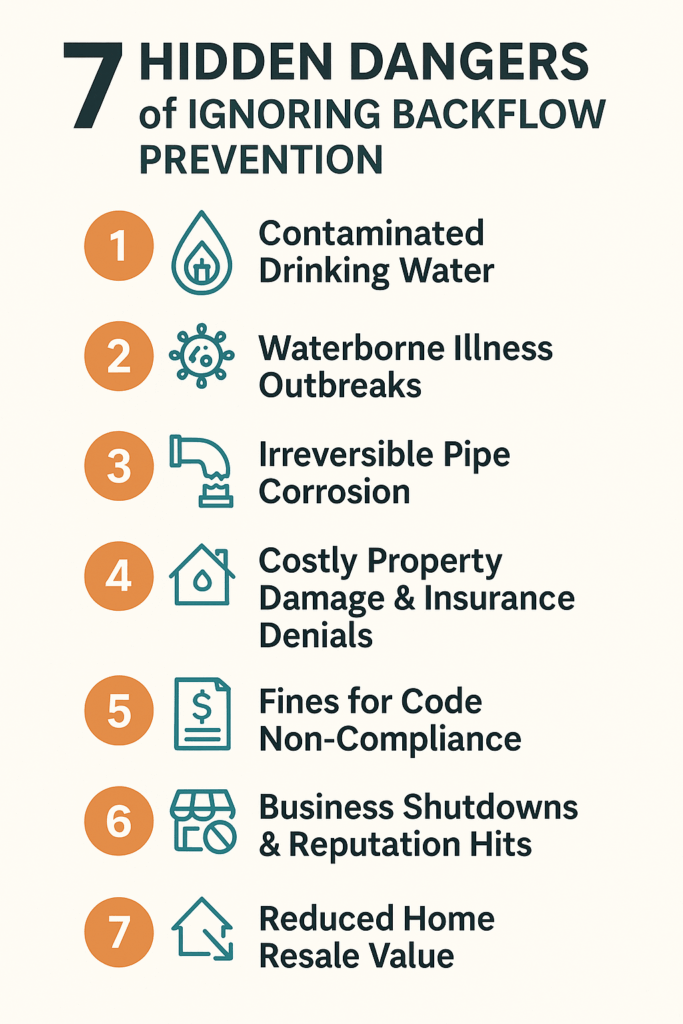


Hidden Dangers of Ignoring Backflow Prevention
Expert Tips

7 Hidden Dangers of Ignoring Backflow Prevention (and How to Fix Them Fast)
Backflow incidents contaminate thousands of U.S. water lines each year—yet many homeowners still overlook the dangers of backflow. Below, you’ll discover seven backflow hazards most property owners never see coming, along with how to fix backflow issues before they ruin your plumbing and your health.
Call Now (724) 530-31001. Contaminated Drinking Water
Backflow lets fertilizers, cleaning agents, and bacteria flow backward into your tap, threatening every sip you take.
How to Fix
- Install a reduced-pressure zone (RPZ) backflow prevention device.
- Schedule annual backflow testing to keep valves debris-free.
2. Waterborne Illness Outbreaks
E. coli, Legionella, and Giardia thrive when cross-connections aren’t protected, creating serious health risks of backflow for families and guests.
How to Fix
- Shock-chlorinate pipes after any positive test.
- Maintain water temperatures above 140°F in hot-water systems to kill pathogens.
3. Irreversible Pipe Corrosion
Chemical back-siphonage accelerates rust and pin-hole leaks in copper and galvanized lines, driving repair costs sky-high.
How to Fix
- Add double-check valves on lawn-irrigation and boiler make-up lines.
- Inspect devices every six months if you have high-mineral water.
4. Costly Property Damage & Insurance Denials
Unchecked backflow can flood basements, and insurers may deny claims if no backflow preventer was installed or tested.
How to Fix
- Keep digital and paper copies of backflow test certificates.
- Pair devices with smart leak detectors for real-time alerts.
5. Fines for Code Non-Compliance
Local plumbing codes—and the International Plumbing Code (IPC) Section 608—levy hefty fines for skipped tests or missing devices.
How to Fix
- Book a certified tester every year (or as mandated in Beaver County).
- Tag each device with a visible inspection date to satisfy inspectors.
6. Business Shutdowns & Reputation Hits
Restaurants, salons, and clinics risk health department closures and negative press when backflow contamination hits.
How to Fix
- Set up a maintenance contract with a licensed plumber who specializes in commercial backflow hazards.
- Train staff to recognize warning signs like water-pressure drops or discolored water.
7. Reduced Home Resale Value
Home inspectors flag missing or failed devices, forcing sellers to cut asking prices or pay for last-minute retrofits.
How to Fix
- Install a University of Southern California–approved preventer before listing your home.
- Provide prospective buyers with recent test results to build trust.
Quick Backflow Prevention Checklist ✅
- Test every 12 months (more often for commercial sites).
- Label each device with the last inspection date.
- Replace worn seals and relief valves immediately.
- Document results—keep copies for five years.
- Monitor water pressure; sudden drops can signal failure.
FAQs About Backflow Prevention
Q: How often is backflow testing required?
A: Most municipalities—including Beaver County—require certified annual testing.
Q: Can I test a backflow preventer myself?
A: DIY testing is illegal in many states; devices must be checked by a certified tester with calibrated gauges.
Q: What’s the average cost of a backflow prevention device?
A: Residential devices range from $150–$600 installed, while commercial RPZ units can top $1,000.
Need Backflow Help Fast? Call Taggart Plumbing!
When it comes to Beaver County plumbing, no one beats Taggart Plumbing’s certified cross-connection specialists. From installing RPZ devices to performing same-day annual tests, Taggart keeps your water safe, your property code-compliant, and your wallet happy.
